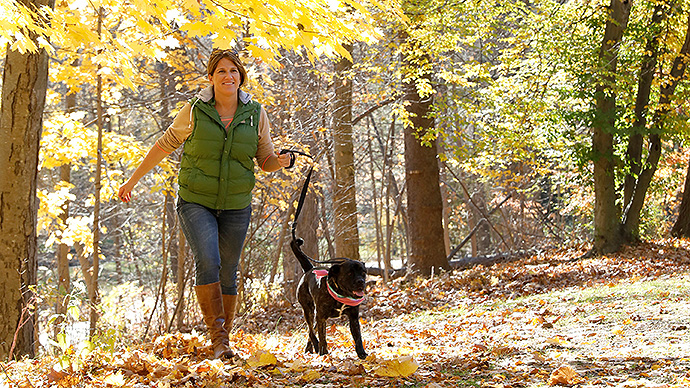Pollen Allergy: A Growing Problem

More of us are seemingly susceptible to hay fever. Why? A mix of global changes and individual factor are interrelated.
Are you one of the many people who secretly dread the arrival of spring each year due to pollen allergy? Rather than celebrating budding flowers, blossoming trees and bird song, for many, spring can signify the start of months of runny noses, itchy eyes and oh so much sneezing. If so, you’re not alone.
According to The World Allergy Organization, allergies (or allergic rhinitis) currently affects between 10% and 30% of all adults around the globe, and up to 40% of children. Allergic reactions to pollen have increased in both frequency and severity in some geographical locations over the last few decades.
Why is this? What’s likely causing populations around the world to become increasingly sensitive to seasonal allergens, such as pollen? And what do we understand and perhaps can do something about it?
While there is no single cause, there are a couple of observations that might be contributing to the prevalence of allergies during pollen season.
Climate Change Lengthens Pollen Season
A growing body of research shows that the warmer temperatures and higher atmospheric carbon dioxide levels caused by climate change are altering flowering seasons worldwide, lengthening pollen seasons and increasing the amount of pollen in the air in some parts of the world.
Pollen seasons are now starting earlier and ending later, especially in the Northern Hemisphere. For example, one study found that between 1995 and 2011, warmer temperatures in the United States caused the pollen season to be 11 to 27 days longer. Those extra days could mean more pollen exposure, which is bad news for America’s 25 million hay fever sufferers as about 75% of them are allergic to ragweed, a common allergen.
A longer growing season and increased carbon dioxide in the atmosphere may be contributing to ragweed growing faster, producing more pollen per plant, and having a higher allergenic content. And a single ragweed plant produces about a billion grains of pollen per an average season, with each grain potentially carried up to 400 miles (644 km) by the wind.
And it’s not just plants. Global warming may also aid the growth of trees that produce more allergenic pollen, such as oak and birch, over less allergenic species like pine. A study in Italy found that over a 27-year period as temperatures increased, the pollen seasons for allergenic trees like olive and cypress, started earlier, lasted longer and affected more people.
Climate change could also impact other airborne allergens. A rise in carbon dioxide emissions could substantially worsen mold allergies. One laboratory test found that a common fungus grown in current carbon dioxide levels produced 8.5 times as much allergenic protein as those grown in pre-industrial carbon dioxide levels.

The Rise of Allergies in Cities
We are also becoming a more urban society, with around 68% of the world’s population predicted to live in towns and cities by 2050. As with increasing pollution along with other factors, the move towards more urban living in various countries has also coincided with a rise in the prevalence of airborne allergies. For example, in one African nation asthma and allergic rhinitis were found to be twice as prevalent in urban settings.
A critical factor in causing this is air pollution. Atmospheric pollutants such as exhaust fumes have been found to have direct effects on the physical, chemical, and biological properties of pollen grains making them more allergenic. Air pollution also makes us more susceptible. When ground-level pollution levels are high, it takes much less pollen to trigger a pollen allergy.
Urban landscapes also bring other problems. They create what are called heat islands, areas several degrees warmer than surrounding rural areas. In these, trees and plants can turn green earlier and stay green longer during the year and thereby produce more pollen.
This is exacerbated by some misguided historical town planning. Many cities had planted male-only trees as they don’t produce the seeds, fruits or pods that can ‘litter’ the streets. They do, however, produce pollen and lots of it. And with little female trees to receive that pollen, city air and streets can become filled with pollen during hay fever season.

A Lack of Exposure in Our Lives
Could our modern, germ-free lifestyles also contribute to the rise in allergies?
From a fall in natural childbirth and breastfeeding, to more time spent indoors and away from the social contact of sport and outdoor activities, less exposure to diverse microbes that help our immune system develop from a young age can increase the risk of developing allergies.
An overly hygienic Western lifestyle is, of course, intended to limit infections and while it does this very successfully, it also likely reduces general microbial exposure. This in turn, is hypothesized to alter the early colonization of the infant human gut, which in turn disrupts the development of our immune systems and lead to a higher disposition to allergies. Interestingly, epidemiological studies have shown that children who grow up on traditional farms, where they have high levels of microbial exposure, appear to be more protected from asthma, hay fever and allergic sensitization.

Are We Allergic to the Future?
Our susceptibility to allergies is exceptionally complex with an individual’s genetic makeup being a fundamental determining factor. But environmental factors also have a hugely important role in their development. The impact of climate change, urbanization and our increasingly sterilized lifestyles are creating an environment where we are increasingly likely to develop allergies to airborne allergens.
Does this mean that hay fever will just become part of our daily lives in the future? Not necessarily. Understanding the causes and risk factors for pollen allergies can help us better manage our symptoms. And while from an individual level it can feel that much of this is out of our control, even small actions that change our local environment might make a big difference to our experience.





















